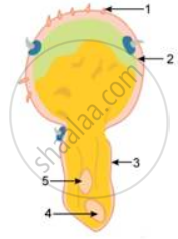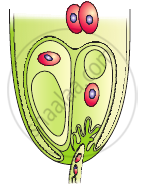Advertisements
Advertisements
Question
Match the items in Column A with those in Column B.
|
Column A |
Column B |
|
(a) Generative nucleus |
(i) Pollen tube |
|
(b) Germ pore |
(ii) Endosperm nucleus |
|
(c) Exine |
(iii) Testa |
|
(d) Secondary nucleus |
(iv) Fertilization |
|
(e) Integument |
(v) Male nuclei |
|
(f) Egg nucleus |
(vi) Rough |
Solution
|
Column A |
Column B |
|
(a) Generative nucleus |
(i) Male nuclei |
|
(b) Germ pore |
(ii) Pollen tube |
|
(c) Exine |
(iii) Rough |
|
(d) Secondary nucleus |
(iv) Endosperm nucleus |
|
(e) Integument |
(v) Testa |
|
(f) Egg nucleus |
(vi) Fertilization |
APPEARS IN
RELATED QUESTIONS
What is triple fusion?
What happens to the following after fertilization?
Stamens
Given ahead is a diagrammatic sketch of the sectional view of a germinating pollen grain. Study the same and then answer the question that follows:

Name the parts labelled 1, 2, 3, 4 and 5.
Given ahead is a diagrammatic sketch of the sectional view of a germinating pollen grain. Study the same and then answer the question that follows:
What is the function of the part labelled '4'?
What happens to the ovary post fertilization?
Long Answer Question:
Draw a labeled diagram of the L.S. of anatropous ovule and list the components of the embryo sac and mention their fate after fertilization.
In majority of plants pollen is liberated at
Double fertilization was first discovered by Nawaschin (1898) in ______.
Find out the CORRECT sequence of events taking place in pollen - pistil interaction.
- Pollen tube enters one of the synergids and bursts to release male gametes.
- Pollen tube enters the ovule through the micropyle of the ovary.
- The pollen tube grows through the stigmatic tissue and then style.
- Pistil recognizes the correct pollen and accepts it.
In the figure given below label the following parts: male gametes, egg cell, polar nuclei, synergid and pollen tube

